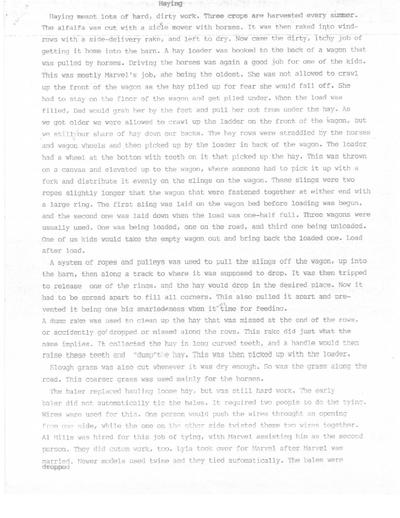Myrt's Memories/Haying
From CowTales
Haying
Haying meant lots of hard, dirty work. Three crops are harvested every summer. The alfalfa was cut with a sickle mower with horses. It was then raked into windrows with a side-delivery rake, and left to dry.
Now came the dirty, itchy job of getting it home into the barn. A hay loader was hooked to the back of a wagon that was pulled by horses. Driving the horses was again a good job for one of the kids. This was mostly Marvel's job, she being the oldest.
She was not allowed to crawl up the front of the wagon as the hay piled up for fear she would fall off. She had to stay on the floor of the wagon and get piled under. When the load was filled, Dad would grab her by the feet and pull her out from under the hay. As we got older we were allowed to crawl up the ladder on the front of the wagon, but we still had our share of hay down our backs.
The hay rows were straddled by the horses and wagon wheels and then picked up by the loader in back of the wagon. The loader had a wheel at the bottom with teeth on it that picked up the hay. This was thrown on a canvas and elevated up to the wagon, where someone had to pick it up with a fork and distribute it evenly on the slings on the wagon. These slings were two ropes slightly longer that the wagon that were fastened together at either end with a large ring. The first sling was laid on the wagon bed before loading was begun, and the second one was laid down when the load was one-half full.
Three wagons were usually used. One was being loaded, one on the road, and third one being unloaded. One of us kids would take the empty wagon out and bring back the loaded one. Load after load.
A system of ropes and pulleys was used to pull the slings off the wagon, up into the barn, then along a track to where it was supposed to drop. It was then tripped to release one of the rings, and the hay would drop in the desired place. Now it had to be spread apart to fill all corners. This also pulled it apart and prevented it being one big snarled mess when it was time for feeding.
A dump rake was used to clean up the hay that was missed at the end of the rows, or accidently got dropped or missed along the rows. This rake did just what the name implies. It collected the hay in long curved teeth, and a handle would then raise these teeth and "dump” the hay. This was then picked up with the loader.
Slough grass was also cut whenever it was dry enough. So was the grass along the road. This coarser grass was used mainly for the horses. The baler replaced hauling loose hay, but was still hard work.
The early baler did not automatically tie the bales. It required two people to do the tying. Wires were used for this. One person would push the wires through an opening from one side, while the one on the other side twisted these two wires together.
Al Mills was hired for this job of tying, with Marvel assisting him as the second person. They did custom work, too. Lyla took over for Marvel after Marvel was married. Newer models used twine and they tied automatically. The bales were dropped on the ground, where they were picked up and loaded on wagons. They were usually unloaded onto a grain elevator to get them into the barn, where they were stacked. It still required a lot of man-power and was back-breaking work. Many farmers now chop the hay in the field and then blow it into a Harvestore silo.
source:Myrtle Jaus Memories. Copywrite:Myrtle Jaus Meyer.
Note:Lyla Jaus often told me about her helping the hired man bale hay and how they would also do custom work. Mom tells of one time when her hand got stuck in the bale and she watched as her arm got pulled towards the chopper. Just before her hand reached the chopper, which would have severed it, her hand came free and she was able to move it out of harm's way.
source:James Baur
<references/>
